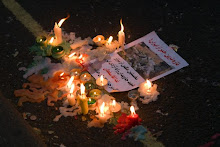However, what makes this catalogue production different and worthy of comment is that, firstly, it follows the standard format with considerable flare and, secondly, and here perhaps it does do something new if not revolutionary, both of the essays are critical - in the sense that they discuss and critique contemporary ceramic work and current trends and developments in a way that allows the reader to think, scrutinise the work, even if only in picture form, and then form his/ her own opinion. The nature of the writing opens up discussion, rather than closing it down. This does mark a tangible progressive development: catalogue essays usually take the form of an introductory essay by the curator or other representative of the host institution, followed by an essay which discusses only the work in the show, usually with little other context, and which is invariably a positive appraisal rather than a serious discursive essay. The result amounts to an exercise in marketing and propaganda rather than an intelligent introduction to new work.
Publishing Ceramics
How ceramics is discussed, either in the pages of a book, in journals, in lectures and presentations, and now, increasingly in the blogosphere and on social networking sites, is a subject close to my heart. The lack of a proper publishing infrastructure for this discipline is something I’ve referred to many times – most recently in my review of Confrontational Ceramics, (Ceramic Review, 235:26). Increasingly, academics and researchers are turning to catalogue essays, as the major source of literature on ceramics, rather than to books which consistently lack substance and concern themselves only with visual representation. There is some freedom of movement in the catalogue form which is not dependent on the commercial demands of a publishing corporation or the weighty history of an esteemed publishing house. Moreover, small institutions, and relatively speaking the Crafts Council and MIMA are minute, could, in principle, take more radical decisions about what constitutes excellence in the field of literary representation of ceramics. They could mobilise digital technology to improve the visual representation, all being well that will materialise with the advent of e-books. Poss and Loss is still stuck with magnificently perfect still photographs, taken from a single angle without much human context. There are many photos so the angles are taken care of – sort of – but, even so, they remain detached from human intervention. There is so much more that could be done.
A Tale Of Two Essays
Glen Adamson’s essay discusses the work in the show, one artist at a time, Jorunn Veiteberg’s discusses the show as a whole in the context of related developments in contemporary ceramic practice. The exhibition was curated by Clare Twomey, who also edited the book and her choice of writers is faultless. Both are immersed in craft, but one, Adamson, is a slight outsider to ceramic work, just enough that he is able to keep a distance and interrogate the work of the four artists, and the other, Veiteberg is very much immersed in ceramic practice but, in the UK at any rate, she is not beholden to any institution or strand of thinking or developments in practice that are grounded in this country. There is just enough detachment in both of them to escape that vexatious sense of cosiness that persists in writing on ceramics.
Outsider Artists
Adamson characterises the four artists firstly as, ‘outsiders’ to the studio pottery model of ceramic practice, while acknowledging that two, Twomey and Keith Harrison are thoroughly grounded in that practice through their art college training and Brownsord, who initially trained in the industry, also migrated to studio practice via the Royal College of Art. Secondly he ascribes ‘typologies,’ to each of them: Brownsord is the historian, Harrison the alien, Sormin the immigrant and Twomey the curator. He then introduces the work as operating in a context imbued with pathos. Referring to the collapse of the ceramics industry in Britain accompanied by the slow eradication of discrete ceramics courses, he sets up a theme of exponential degradation, ‘the ‘medium feels more fragile than usual… news is bad… slow motion collapse… abandoned…downgraded… mounting wreckage…’ etc etc. That sets the scene for the phoenix from the ashes or rather the ‘punk concert in a tea room.’ He then builds the bad-boy metaphor into a mildly rapacious declaration of war against MIMA’s ‘chaste galleries,’ and, by implication, against studio pottery, which the exhibition, ‘takes by storm, possibly by the throat.’ Don’t get me wrong, I’m delighted I’m not the only one who refers to the highly problematic notion of ceramics a ‘virtuous female,’ it’s just I’d rather constitute the achievements of this show as emancipatory rather than as violation. After all, all four have training in ceramics, three in a very orthodox sense and, for all I know, Sormin’s training may also have been very orthodox. They themselves chose to disrupt the virtue of the discipline, they didn’t come under attack.
That said, it’s a fine essay and immensely helpful to the many of us who did not see the show. As a general comment, I’d say he sounds assured about Brownsword and Twomey - he has a clear sense that he knows who they are and what they’re up to. He sounds uncertain and, possibly, unconvinced about Sormin’s work and is amused and also entranced by Harrison who he perceives primarily as a performance artist using the tropes of ceramics and Marxism in his performance rather than having any real attachment to either of them.
Continuity or Collapse: Ceramics in a post industrial era
Jorunn Veiterberg is an altogether more sober writer and more immersed in contemporary ceramic practice – certainly in contemporary studio practice. She takes as her starting point, almost as a given, the understanding that the industry has migrated to the studio and that studio potters are now deeply immersed in industrial as well as 20th century studio practices. Her essay is a survey of contemporary practice related to the industry and to collaborative, or community, non-individualistic practices. Thus the essay ranges from the work of groups like We Work In A Fragile Material and Temp, both Scandinavian groups who work collectively with what ceramics means as well as with what it does, to Marek Cecula, based in the USA and very much the individual studio artist practitioner, but one who designs for industry as well. The latter is not a new model. Cecula’s is the traditional model. Studio practice alone is very unusual indeed and probably took off only when the growth in arts schools meant that artists could teach. Otherwise artists of all kinds have always worked for public institutions, be it frescoes for churches or portraits for monarchs and their courtiers.
Veiteberg discusses the rise and rise of the readymade as a material in individual studio ceramic practices and ends with Christin Johanssen’s ‘Feminoir,’ the urinal for women which operates, according the artist, ‘in the borderland between industrial design and fine arts.’ Johanssen makes work in the studio that imitates industrial design. She sees this area of practice as a way to ‘question and discuss function and design,’ which Veiteberg seems to agree with. I hope that ceramics, as it reinvents itself in what Veiteberg calls, the ‘post-industial’ age, won’t be quite so po-faced that artists feel obliged to be ‘questioning and discussing function and design,’ all the time. I’m slightly concerned that this is going to be virtue reinvented. It’s a bit clean and worthy sounding – which is funny, when you consider how witty and un-worthy ‘feminoir’ is.
Veiterberg’s writing produces ceramic practice as an immensely self-conscious process - this is in some contrast to Adamson, who has a brief love affair with something he perceives as mad and dangerous, in the positive sense of those words, but then extricates himself. The book is a good read about current practice and is illuminating and hard working – by which I mean that a relatively small amount of writing about one exhibition with a finite number of images does an enormous amount to inform and gives the reader a clear sense of an expanding practice at an exciting point of departure.











































